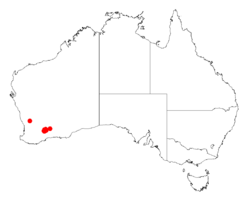Biology:Acacia repanda
| Acacia repanda | |
|---|---|
| Scientific classification | |
| Kingdom: | Plantae |
| Clade: | Tracheophytes |
| Clade: | Angiosperms |
| Clade: | Eudicots |
| Clade: | Rosids |
| Order: | Fabales |
| Family: | Fabaceae |
| Subfamily: | Caesalpinioideae |
| Clade: | Mimosoid clade |
| Genus: | Acacia |
| Species: | A. repanda
|
| Binomial name | |
| Acacia repanda R.S.Cowan & Maslin
| |

| |
| Occurrence data from AVH | |
Acacia repanda is a shrub belonging to the genus Acacia and the subgenus Juliflorae that is endemic to a small area in western Australia .
Description
The rounded to obconic shrub typically grows to a height of 0.5 to 2 metres (2 to 7 ft). The single stemmed and multi-branched plant has minni-ritchi bark[1] and branchlets that have spreading hairs. Like most species of Acacia it has phyllodes rather than true leaves. The patent to ascending evergreen phyllodes are terete to flat with a linear to linear-oblanceolate shape that is slightly to moderately incurved. The rigid, glabrous and grey-green coloured phyllodes have a length of 2.5 to 6 cm (0.98 to 2.36 in) and a width of 1 to 3 mm (0.039 to 0.118 in) have eight prominent nerves with deep furrows between each nerve.[2] It blooms from June to August producing yellow flowers.[1] The simple inflorescences occur in pairs in the axils with sessile and spherical to broadly ellipsoid shaped flowerheads with a length of 5 to 8 mm (0.20 to 0.31 in) and a diameter of 4 to 5 mm (0.16 to 0.20 in) containing 20 to 25 golden coloured flowers. After flowering coriaceous seed pods with a narrowly oblong shape form that are strongly undulate. The pods have a length of up to around 3 cm (1.2 in) and a width of around 4 mm (0.16 in) and are shaggy with golden or white hairs and some smaller red resin-hairs throughout. The glossy dark-brown to black seeds are also sometimes mottled yellow have a broadly elliptic to oblong-ovate shape and are 2.5 to 3 mm (0.098 to 0.118 in) in length.[2]
Distribution
It is native to a small area in the southern Wheatbelt region of Western Australia[1] where it has a disjunct distribution with the bulk of the population being found in the area around Holt Rock with a small population found in Wongan Hills. It is often situated around outcrops of granite growing in sandy loam or loamy soils as a part of heath or shrubland communities.[2]
See also
References
- ↑ Jump up to: 1.0 1.1 1.2 "Acacia repanda". FloraBase. Western Australian Government Department of Parks and Wildlife. https://florabase.dpaw.wa.gov.au/browse/profile/14139.
- ↑ Jump up to: 2.0 2.1 2.2 "Acacia repanda R.S.Cowan & Maslin". Wattle - Acacias of Australia. Lucid Central. https://apps.lucidcentral.org/wattle/text/entities/acacia_repanda.htm. Retrieved 10 April 2020.
Wikidata ☰ Q15288553 entry
 |


